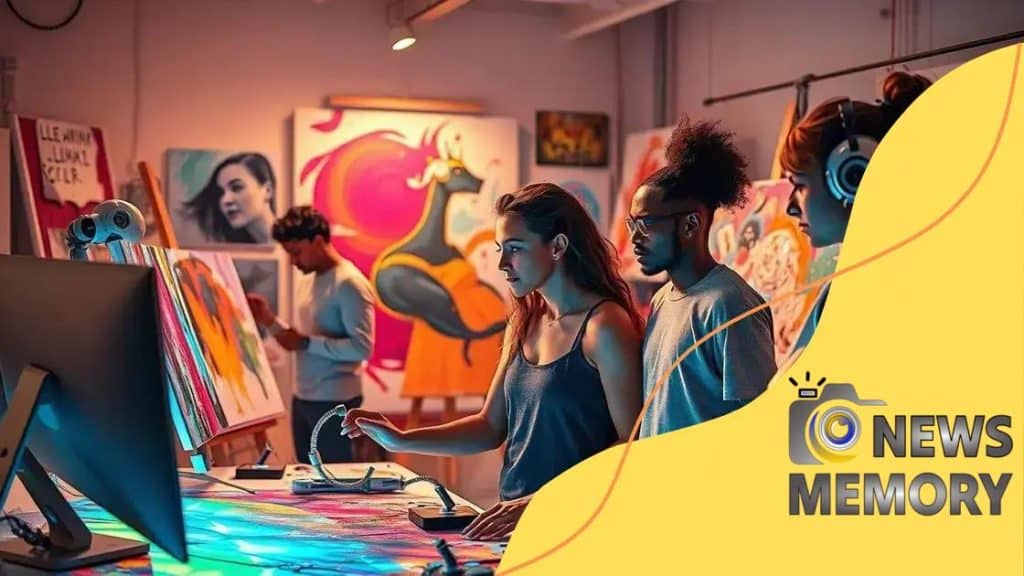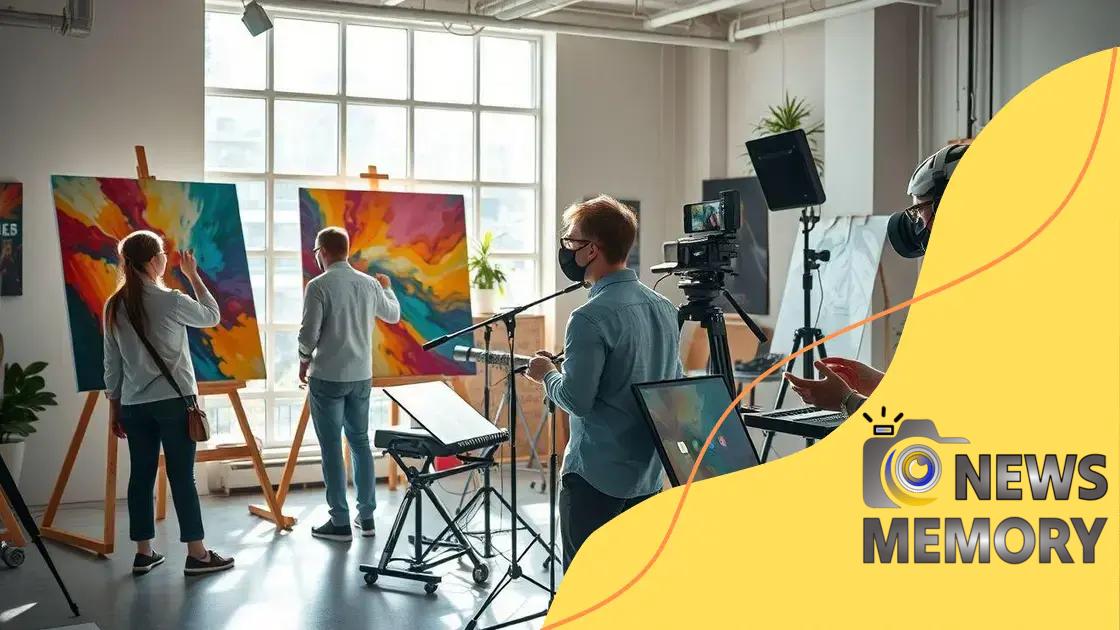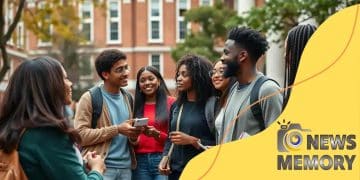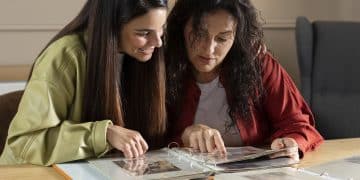The role of AI in transforming the creative industries

The role of AI in transforming the creative industries involves enhancing artistic expression, fostering collaboration, and addressing ethical challenges, ultimately reshaping how creators produce and share their work.
The role of AI in transforming the creative industries is a fascinating topic. Have you ever wondered how artificial intelligence can enhance artistic endeavors? In this article, we’ll dive into its remarkable influence.
Understanding the impact of AI on creativity
Understanding the impact of AI on creativity reveals how technology reshapes our artistic expressions and processes. It’s fascinating to see how artificial intelligence not only inspires artists but also enhances their work.
AI influences creativity in multiple sectors, from visual art to music. It allows creators to explore new dimensions and possibilities. For instance, artists can now collaborate with algorithms that suggest variations of their work, ensuring a fresh perspective.
How AI Assists Artists
One of the most exciting aspects is how AI can assist artists in their creative journey. It provides tools that make the process easier and more innovative:
- Automated design tools that generate ideas.
- Music composition software that collaborates with musicians.
- Image generation that sparks new concepts.
- Data analysis tools that identify trends.
Moreover, AI helps democratize creativity by making artistic tools accessible. Anyone with internet access can start creating, regardless of their skill level. This shift fosters a vibrant landscape where more people can express their ideas.
Challenges of AI in Creative Fields
However, the integration of AI into the creative industries isn’t without challenges. Some artists fear that reliance on technology might undermine their originality. Critics argue that algorithms can stifle the uniqueness inherent in human creativity.
In addition, there are ethical concerns regarding copyright and ownership of AI-generated artworks. These issues need careful consideration as we move forward in embracing technology. The balance between leveraging AI and maintaining artistic integrity remains a crucial discussion.
Despite these challenges, the future of creativity intertwined with AI looks promising. As technology evolves, it opens new avenues for expression. Artists who adapt to these changes can thrive in innovative environments.
AI tools reshaping artistic expression
AI tools reshaping artistic expression are transforming how creators approach their craft. The integration of artificial intelligence into the creative process offers exciting opportunities and challenges.
Artists now have access to powerful tools that enhance their capabilities. By using AI, they can explore new styles and techniques that were previously unimaginable.
Types of AI Tools Used in Art
There are several types of AI tools that artists are using to innovate:
- Generative art applications that create unique visuals based on algorithms.
- Music composition software that can generate melodies and harmonies.
- Editing tools that analyze and enhance photographs.
- Interactive installations that respond to audience input.
These tools empower artists to push their boundaries and experiment more freely. For example, some painters use AI to generate initial ideas, which they then customize and refine. This collaboration between human creativity and machine learning can lead to stunning results.
Enhancing Collaboration in Arts
Additionally, AI fosters collaboration among artists. It allows musicians to work with digital soundscapes and visual artists to explore new dimensions in their works. With AI tools, the lines between different art forms are blurring, creating hybrid art that defies traditional categories.
While embracing these new technologies, artists also face the challenge of defining their unique voice. The risk of becoming too reliant on tools may lead to questions about originality. However, the key lies in using AI as an assistant rather than a replacement for human creativity.
As we move forward, the potential of these tools will continue to evolve. The future will likely see even more innovative applications of AI that will further shape artistic expression.
Case studies: AI success in creative projects

Case studies of AI success in creative projects highlight the transformative power of artificial intelligence in various artistic fields. Many artists, organizations, and companies have integrated AI into their workflows, leading to remarkable outcomes.
One notable example is the collaboration between AI and visual artists. For instance, an artist used a machine learning algorithm to generate a series of unique paintings. The AI studied thousands of artworks and created new pieces based on learned styles. This blend of human intuition and AI innovation allowed the artist to explore a broader range of expression.
Music and AI Innovations
In the music industry, AI has also gained traction. Music composers use AI tools to aid in writing songs. One prominent case is when an AI program composed a symphony that was performed by a live orchestra. The system analyzed existing music to produce a piece that captivated audiences. This shows how technology can inspire creativity while supporting artistic vision.
- AI-generated music can adapt to audience feedback.
- Artists collaborate with AI to create hybrid music genres.
- Platforms like OpenAI’s MuseNet can compose original works.
- AI helps musicians save time on repetitive tasks.
Another striking example involves storytelling and writing. AI has been used to draft compelling narratives and develop characters in literature. Writers harness this technology to brainstorm ideas and enhance the writing process. The collaboration between human writers and AI generates fresh creative narratives that merge traditional storytelling with innovative ideas.
Film and Animation Projects
In film and animation, AI has streamlined production processes. From script analysis to visual effects, AI tools optimize workflows and increase efficiency. A famous instance is the use of AI to enhance video editing, allowing filmmakers to achieve their vision faster. This technology analyzes footage and makes suggestions, which can save days of editing time.
These case studies demonstrate that the success of AI in creative projects is only beginning. Artists and creators worldwide explore its potential, leading to exciting developments in various art forms. Embracing AI gives creative professionals new avenues to express ideas and tell stories.
Challenges facing AI in creative fields
Challenges facing AI in creative fields are significant and complex. As artificial intelligence becomes more integrated into the creative process, several issues must be addressed to ensure a harmonious relationship between technology and artistry.
One major concern is the fear of losing originality. Artists worry that relying too heavily on AI might dilute their personal style or voice. This raises questions about the authenticity of art produced with AI assistance. Are these works truly original, or just variations of existing styles?
Ethical and Copyright Issues
Another critical challenge involves ethical considerations. The use of AI for creating art can lead to copyright disputes. If an AI generates a piece based on existing works, who owns the final product? These legal questions are complex and not yet fully resolved.
- The legislative framework around AI-generated content is still developing.
- Artists may face challenges in proving ownership of their work.
- Fair compensation for human creatives versus AI contributions is debated.
- There is a risk of plagiarism if AI tools replicate existing styles too closely.
Moreover, AI tools are only as good as the data they are trained on. If the training data is biased or limited, the outputs will reflect those shortcomings. This can lead to unintentional reinforcement of stereotypes or omissions of diverse artistic expressions.
Integration and Technical Limitations
The integration of AI into creative fields is another hurdle. Many artists are not tech-savvy and may struggle to incorporate these tools into their workflow. This technological divide can limit access for some creative professionals, creating disparities within the industry.
Finally, there’s a concern about job displacement. As AI continues to evolve, some fear that it could replace jobs in creative sectors. While AI can enhance creativity, there is apprehension that it might render certain jobs obsolete. Striking a balance between embracing innovation and preserving human jobs is essential.
Future trends in AI and creativity
Future trends in AI and creativity will shape the way we think about art and expression. As artificial intelligence continues to develop, it presents exciting opportunities and challenges for creators.
One key trend is the increasing personalization of creative content. AI algorithms are becoming more adept at analyzing individual preferences. This allows artists and creators to tailor experiences for specific audiences. The customization trends will make art more accessible and engaging to diverse groups.
Collaborative AI Tools
Another significant shift is the rise of collaborative AI tools that work alongside artists. These tools can provide insights, suggest creative directions, and even help in refining ideas. AI can function as a partner in creativity rather than just a tool, leading to unique outcomes. This collaboration enhances the creative process by merging human intuition with machine learning.
- New platforms for artists to showcase AI-assisted work.
- Increased accessibility to advanced AI technologies for all creators.
- Growing community and networks around AI and art.
- Potential for hybrid art forms that combine various disciplines.
Moreover, as AI becomes more prevalent, ethical considerations will become increasingly important. Discussions around ownership, copyright, and artistic integrity will continue to evolve. Artists will need to navigate these complexities to ensure their rights and values are upheld in the digital landscape.
The Role of AI in Education
Education will also play a vital role in the future of AI and creativity. As new technologies emerge, educational institutions will need to adapt their curricula to prepare students for a world where AI is a prominent part of creative fields. This includes teaching new tools and understanding the implications of using AI in the creative process.
Creativity will no longer be defined solely by human effort. The future will see a blending of human and machine creativity, allowing for richer and more varied artistic expressions. Embracing these changes will enable artists to innovate and grow in ways previously thought impossible.
FAQ – Frequently Asked Questions about AI in Creative Industries
What are the main benefits of using AI in creative fields?
AI enhances creativity by providing new tools and ideas, allowing artists to experiment and collaborate in innovative ways.
How does AI affect the originality of artwork?
There are concerns that AI-generated content may lack originality, but it can also serve as a tool to enhance human creativity, creating unique expressions.
What ethical issues arise from using AI in art?
Ethical issues include copyright concerns, ownership of AI-generated art, and the potential for bias in AI output, which need to be carefully navigated.
How can artists adapt to the changes brought by AI?
Artists can embrace AI technology by learning to use new tools, collaborating with AI systems, and finding ways to incorporate these technologies into their creative processes.





